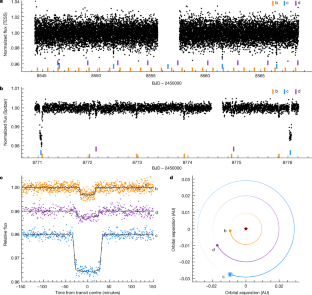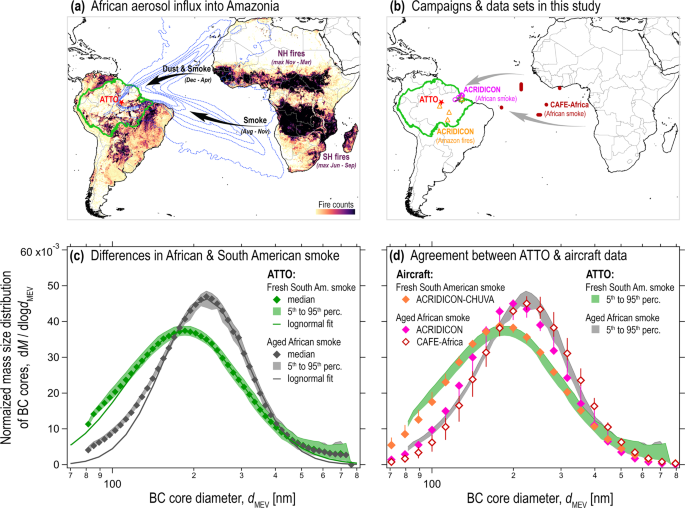天文学者は、火山に覆われた可能性の高い別の地球を発見した。 Astronomers discover alternative Earth likely covered with volcanoes
2023-05-17 カリフォルニア大学リバーサイド校(UCR)
◆火山活動は大気形成に重要であり、液体の水を維持する可能性がある。また、この惑星は回転せず、常に同じ面が恒星に向かっている。昼側は非常に熱く、液体の水は存在しないが、惑星全体に広がる火山活動により、夜側では水が凝縮する可能性がある。
◆この惑星は居住可能ではないが、火山の存在は進化に関する情報を提供する。火山活動によって大気が増え、地球のような大気を持つ惑星では温室効果ガスが働き、温暖な状態を維持する。
◆地球と同じ大きさの惑星でも、プレートテクトニクスが存在しなくても大気を増やすことができることが示されている。金星での火山活動の発見は、火山が惑星環境を形成する上で重要な役割を果たすことを示している。
<関連情報>
- https://news.ucr.edu/articles/2023/05/17/are-earth-and-venus-only-volcanic-planets-not-anymore
- https://www.nature.com/articles/s41586-023-05934-8
M6恒星を通過する潮汐加熱のある温和な地球サイズの惑星 A temperate Earth-sized planet with tidal heating transiting an M6 star
Merrin S. Peterson,Björn Benneke,Karen Collins,Caroline Piaulet,Ian J. M. Crossfield,Mohamad Ali-Dib,Jessie L. Christiansen,Jonathan Gagné,Jackie Faherty,Edwin Kite,Courtney Dressing,David Charbonneau,Felipe Murgas,Marion Cointepas,Jose Manuel Almenara,Xavier Bonfils,Stephen Kane,Michael W. Werner,Varoujan Gorjian,Pierre-Alexis Roy,Avi Shporer,Francisco J. Pozuelos,Quentin Jay Socia,Ryan Cloutier,Jeremy Dietrich,Jonathan Irwin,Lauren Weiss,William Waalkes,Zach Berta-Thomson,Thomas Evans,Daniel Apai,Hannu Parviainen,Enric Pallé,Norio Narita,Andrew W. Howard,Diana Dragomir,Khalid Barkaoui,Michaël Gillon,Emmanuel Jehin,Elsa Ducrot,Zouhair Benkhaldoun,Akihiko Fukui,Mayuko Mori,Taku Nishiumi,Kiyoe Kawauchi,George Ricker,David W. Latham,Joshua N. Winn,Sara Seager,Howard Isaacson,Alex Bixel,Aidan Gibbs,Jon M. Jenkins,Jeffrey C. Smith,Jose Perez Chavez,Benjamin V. Rackham,Thomas Henning,Paul Gabor,Wen-Ping Chen,Nestor Espinoza,Eric L. N. Jensen,Kevin I. Collins,Richard P. Schwarz,Dennis M. Conti,Gavin Wang,John F. Kielkopf,Shude Mao,Keith Horne,Ramotholo Sefako,Samuel N. Quinn,Dan Moldovan,Michael Fausnaugh,Gábor Fűűrész & Thomas Barclay
Nature Published:17 May 2023
DOI:https://doi.org/10.1038/s41586-023-05934-8

Abstract
Temperate Earth-sized exoplanets around late-M dwarfs offer a rare opportunity to explore under which conditions planets can develop hospitable climate conditions. The small stellar radius amplifies the atmospheric transit signature, making even compact secondary atmospheres dominated by N2 or CO2 amenable to characterization with existing instrumentation1. Yet, despite large planet search efforts2, detection of low-temperature Earth-sized planets around late-M dwarfs has remained rare and the TRAPPIST-1 system, a resonance chain of rocky planets with seemingly identical compositions, has not yet shown any evidence of volatiles in the system3. Here we report the discovery of a temperate Earth-sized planet orbiting the cool M6 dwarf LP 791-18. The newly discovered planet, LP 791-18d, has a radius of 1.03 ± 0.04 R⊕ and an equilibrium temperature of 300–400 K, with the permanent night side plausibly allowing for water condensation. LP 791-18d is part of a coplanar system4 and provides a so-far unique opportunity to investigate a temperate exo-Earth in a system with a sub-Neptune that retained its gas or volatile envelope. On the basis of observations of transit timing variations, we find a mass of 7.1 ± 0.7 M⊕ for the sub-Neptune LP 791-18c and a mass of 0.9+0.5−0.4M⊕0.9−0.4+0.5⊕ for the exo-Earth LP 791-18d. The gravitational interaction with the sub-Neptune prevents the complete circularization of LP 791-18d’s orbit, resulting in continued tidal heating of LP 791-18d’s interior and probably strong volcanic activity at the surface5,6.



